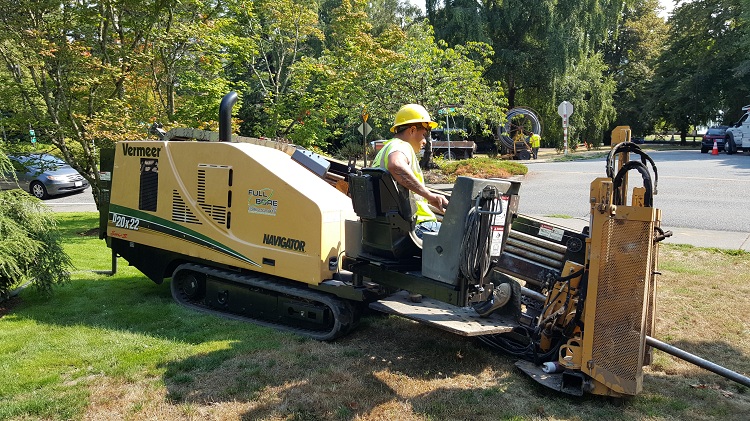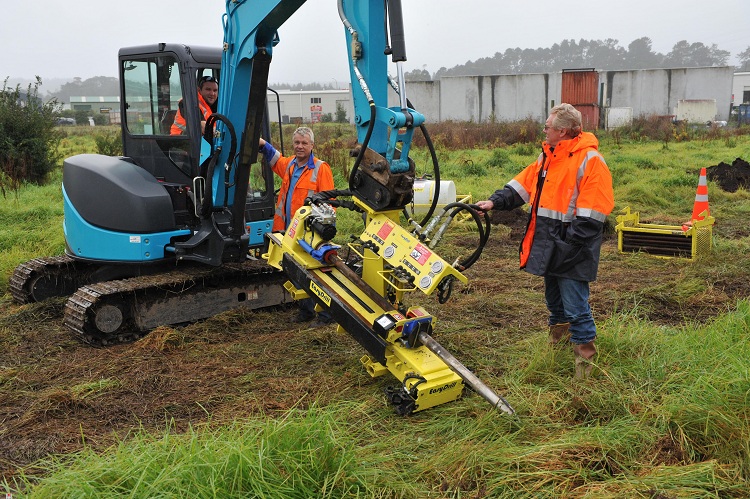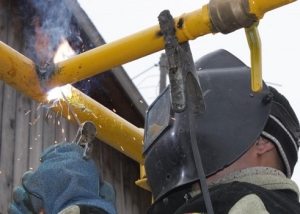Horizontal directional drilling (HDD) is a method of laying pipes, as well as cables without digging trenches, performed, as a rule, under roads and railways. To implement this method, a special technique is used, which includes directional drilling rigs. With the help of such installations, work is carried out 90% underground.
Content
Purpose and main advantages of the HDD method
The method of horizontal directional drilling is today considered to be very popular. First of all, this is due to the fact that the use of this method allows to reduce the financial costs of laying the pipeline by 2.5–3 times.
Consider the main tasks that are performed through this method:
- laying pipes that will serve as a protective case (casing) for various power cables;
- HDD technology allows trenchless installation of pipelines that transport drinking water or wastewater.
Important! A puncture under the railway or autoblank is the only option for installing communication without digging a traditional trench.
GNB puncture under a road or other engineering construction allows you to save the natural landscape, which is also an important advantage. Consider other advantages of HDD:
- in addition to financial expenses, labor costs are also reduced, since the main work is performed by special equipment;
- with the help of a GNB puncture, it is possible to lay a pipeline or cable channel not only under transport routes, but also under water bodies.
- such work does not require a large number of people. As a rule, a fairly small team consisting of 3-5 people.

To perform such work does not require a lot of space, and the surrounding landscape will not be damaged
Drilling horizontal wells can rightfully be considered a unique way, the technology of which eliminates environmental damage and reduces labor costs, as well as cash costs.
Necessary equipment
All the equipment that is used for drilling by the HDD method is divided into several main varieties:
- machine for horizontal directional drilling of HDD;
- location system for drilling;
- minor accessories (staples, locks, etc.).
A location system for drilling horizontal wells is necessary to establish control over the drill. This is very important, since the drill is in the soil during operation, that is, outside the visible zone. Such a system prevents the drill from colliding with various obstacles that could damage the drilling equipment.
The geolocation system for controlling the workflow is equipped with a mini-probe, which is necessary to track geolocation indicators during drilling. The mini probe is installed on the drill head and on the device. The data transmitted by the probe is sent to the operator, who corrects the workflow.
It is worth noting that the equipment for HDD is quite expensive and refers to professional equipment.A horizontal drilling rig (UGB) can have a different configuration, however, all such machines consist of the following structural elements:
- body;
- engine;
- chassis.
The functional part of UGNB consists of three main components:
- drilling element;
- a hose that supplies water to the drill element (this is necessary to cool the drill);
- Control Panel.
All UGNB are classified according to one main indicator - the boundary pulling force. Other characteristics of these machines include:
- indicators of the cross section of the channel that such a machine can perform;
- maximum channel length;
- concrete consumption rate (l / min);
- the use of the horizontal drilling method also takes into account the maximum possible bending radius of the drill rods. This indicator is considered very important, as it affects the mobility of the rig and its ability to bypass various obstacles.
The following devices are referred to secondary equipment:
- fixing elements;
- adapters;
- expanders;
- pump equipment;
- generators, powered by electricity;
- devices for lighting.
The horizontal drilling rig must be selected correctly, in accordance with all the factors listed above.
Preparatory work before the HDD
Horizontal drilling involves a puncture carried out by professional equipment. However, before starting drilling under the road, it is necessary to carry out preparatory work.
First of all, you need to prepare a flat platform for the drilling rig. To do this, it is necessary to level the site, which should have an approximate size of 10x15 m. In addition, in some specific situations, you can not do without preparing a bypass for the drilling complex.
Important! The prepared site must be shielded with a warning tape. This is necessary in order to prevent the penetration of strangers into the territory. This tape is installed at a height of about 80 cm above the ground.
A platform for drilling equipment is prepared in the place where the well will be laid. After preparing the site, it is necessary to install the drilling equipment and place it in the right position for making a puncture.
In addition, it is worth anchoring the base plate for equipment. This event is carried out by means of augers. Next, you need to adjust the angle of entry of the drill into the ground.
A puncture method of horizontal directional drilling of HDD is carried out taking into account safety precautions, as well as all the necessary building codes. In the process of drilling, a special bentonite solution is used. The apparatus preparing this solution should be on the side of the horizontal directional drilling rig. The distance between the UGNB and the installation for the preparation of bentonite should be at least 10 m. Bentonite solution performs the following functions:
- strengthening the walls of the channel borehole;
- and also this solution helps to remove soil from the channel.
In the places of entry and exit of the channel, it is recommended that special pits be arranged in which excess solution will be disposed of. In addition, it is necessary to establish a constant radio communication between the head of the drilling process and equipment operators.
Consider what else needs to be done in preparation for horizontal drilling of HDD:
- identify places where underground utilities pass, so as not to hurt them while drilling;
- to study the composition of the soil and its features. This is necessary to select the optimal drilling route.
Pilot well completion
After all the preparatory work is done, you can proceed directly to the laying of pipes by horizontal directional drilling. For this, the drilling rig is located in the right place. Next, you need to perform a check (pilot well). The cross-sectional indicators of such a well should be approximately 100 mm.
When organizing a pilot well beneath railroad tracks or a road, the movement of the drilling element must be controlled by a geolocation system. Without such a system or in the event of its malfunction, trenchless work is prohibited.
The initial position of the drill head is typically 10–20 ° relative to the horizon. This angle should constantly decrease depending on the depth of immersion. After the required depth is reached for laying the pipeline by the HDD method, drilling is carried out in a horizontal plane. During drilling, adjustments to the movement of the drill bit are permitted. Correction of the drill movement is carried out if it deviates from a given trajectory. The deviation from the desired path is determined using a positioning system.
The puncture method involves checking the position of the drill through a geolocation system every 3 m. After passing a certain point, the drill head begins to move up, which allows you to reach the exit point. The exit from the ground (as well as the entrance) must be pre-calculated and performed at a strictly defined angle.
Expansion
At the next stage of laying pipes under the road, it is necessary to expand the pilot channel. For this, the drill head is dismantled, and a special device is installed in its place - a rimmer. Rimmer is a structural element used when laying pipes using the HDD method, which performs the function of expanding the pilot channel. It is worth noting that the rimmer is an expander of the reverse action (it stretches from the channel output to its input).
Taking into account HDD drilling technology, in order to achieve the required diameter indicators, expansion is carried out from one to several times. The number of extensions depends on what diameter the future well should have.
Horizontal drilling can be carried out in difficult conditions (poor soil, an abundance of obstacles in the way of the drill, etc.). In this case, work to expand the well is performed before the necessary communications are laid in the canal. In addition, it is worth noting that all work must be carried out using coolant. This is due to the fact that geolocation equipment is very sensitive to elevated temperatures. The puncture of the road is a serious event, which should be thought out from beginning to end.
There is another important factor that should be foreseen - shedding of soil. A puncture under an expensive HDD method should also take into account the fact that before they start drawing plastic or metal pipes into the well, they must be connected. The design must be securely connected, otherwise problems may arise. Further, when the drilling equipment is off, the annular expander is docked with the rods. Then, through the rotating swivel, the necessary communication is joined. For docking, a special adapter element or other possible device is required.
Helpful information! The HDD method takes into account the selection of the expansion part according to this calculation: the channel should be 25% more than the stretched pipeline. If the communication is laid with thermal insulation, then the channel should be 50% larger.
If the pressure inside the channel is large, then the bentonite solution evenly fills the space between the outer wall of the pipe and the inner wall of the well. After the bentonite solution hardens, soil subsidence is eliminated.
Pipeline laying
The puncture under the railway or roadbed is performed first. Next, the well is expanded to the desired diameter. At the third stage, pipes are laid using the HDD method.
This is done quite simply: the pipeline is tightened along with the last expansion rimmer. The communication to the expander is fixed by means of special connecting brackets or swivel.
Previously, the conductor is pulled through the finished channel. This is necessary when organizing cabling in communication. In this case, the pipeline design will serve as a protective casing that protects the wiring in the ground from damage.
This technology allows you to quickly, reliably and economically stretch the pipeline through the ground without organizing trenches, which are usually performed manually. After laying the pipeline, the HDD can be considered completed. In the end, it is necessary to evacuate drilling and other equipment from the work site.











